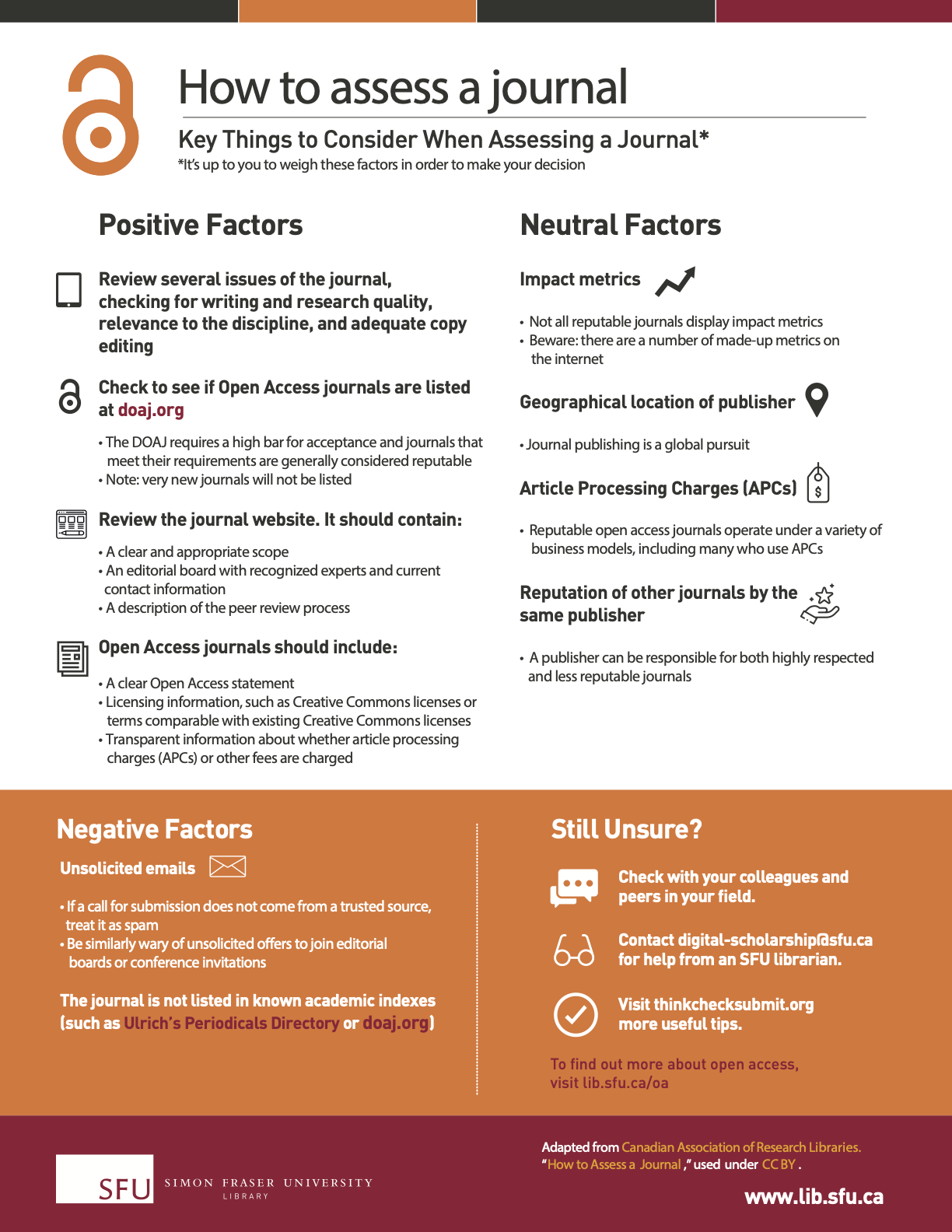On this page
How do I assess a publisher, journal, or conference?
Assessing a publisher or journal before you submit your work is an important step to avoid deceptive or predatory publishers and insure that the publication is committed to sharing high-quality scholarship to advance the field of research.
If you're writing a research paper or thesis, you may also need to check the quality of a publisher or journal before deciding which sources to cite in your paper.

Deceptive publishers, also commonly referred to as "predatory", produce journals and books that are not edited or peer reviewed, and frequently pose as legitimate open access publications. They often charge exorbitant fees to unsuspecting researchers who agree to publish their work with them.
Follow the steps below to assess a publisher or journal.
1. Research the journal and publisher
You can also visit Think. Check. Submit: a campaign to help researchers identify trusted journals and publishers for their research.
Think. Check. Submit. from Think. Check. Submit. on Vimeo.
2. Consider the impact metrics
Research the impact metrics, index rates, and statistics of journals you’re considering publishing with.
- Journal-level impact metrics measure a journal’s impact and relative importance in the field, generally through the calculation of citation counts.
- Ulrich’s Periodical Directory includes a list of databases where a journal is indexed, indicating how accessible articles will be to other researchers, as well as whether or not the journal is peer-reviewed.
3. Ask your liaison librarian
Contact your liaison librarian who can help find details and evaluate the reputability of a publisher or journal. These librarians are subject specialists with knowledge of specific journals in your discipline.
Additional resources
- Check out our post on Getting Published: Tips for choosing an academic journal for general suggestions about journal publishing, including where to look for possible journals and options for making your work open access.
Use these resources to help you evaluate publishers and journals:
- Open Access Scholarly Publishers Association (OASPA) Code of Conduct
- International Association of Scientific, Technical & Medical Publishers (STM) Code of Conduct
- Committee on Publication Ethics (COPE) Code of Conduct for Journal Publishers
Avoiding predatory (non-reputable or deceptive) conferences
In addition to the risk of predatory publishers, researchers should be wary of non-scholarly, revenue-seeking groups organizing predatory or “vanity” conferences. Researchers are asked to pay a fee for the “privilege” of speaking at, chairing, or attending these conferences, which are usually sparsely-attended and often lack the attendance of prestigious speakers who were advertised.
Read more about predatory conferences in this article by The Huffington Post: Predatory Conferences Undermine Science And Scam Academics.
Think. Check. Attend is an initiative to help researchers assess whether a conference is a legitimate, professional opportunity or a potential scam that should be avoided. Follow the guidelines in the checklist to decide when to accept or decline invitations to present and share your research.
Know your rights as an author
If you intend to make your work openly available through open access by depositing it in a repository, or if you are required to do so by your funding agency (such as through the Tri-Agency Open Access Policy on Publications), it’s important to retain your right to archive your work.
Following the peer-review process and after an article has been accepted for publication, publishers require authors to sign a copyright transfer agreement or license to publish consent form before proceeding with formal publication. Ask yourself the following:
- What rights as an author do I retain?
- Can I make copies for my own lectures or classroom instruction?
- Can I post the work on my university/research website or in a repository?
- Can I distribute my work to colleagues and/or students who request a copy?
Check Jisc's open policy finder (former Sherpa/Romeo) for the archiving permissions that are normally included with a publisher's copyright transfer agreement:
- Green - authors may archive pre-print (prior to any peer review) and post-print
- Blue - authors may archive post-print (final draft after peer review).
- Yellow - authors may archive pre-print
- White - authors may not deposit work to an archive nor to an institutional repository.
Review the descriptions of document versions for details about how to identify the pre-print, post-print, and publisher versions.
How to retain your copyright
When the standard copyright agreement limits your rights as an author, you can negotiate with your publisher the retention of your right to reproduce, reuse and publicly present your work for non-commercial purposes. Choose one of the following addendums to apply to your publisher agreement.
Canadian Author Addendum to Publication Agreement (by CARL and SPARC)
Use this Addendum to secure a more balanced agreement with Canadian funding agencies by retaining select rights, such as the right to reproduce, reuse, and publicly present the articles you publish for non-commercial purposes.
This form complies with granting council public access policies, such as the Canadian Institutes of Health Research (CIHR) Policy on Access to Research Outputs.
SPARC Author Addendum
The Scholarly Publishing and Academic Resources Coalition created this addendum for authors to preserve key rights as the author of the journal article.
Scholars Copyright Addendum Engine
Generate a PDF form which you can attach to a journal publisher's copyright transfer agreement, and which reserves certain rights for the author.



